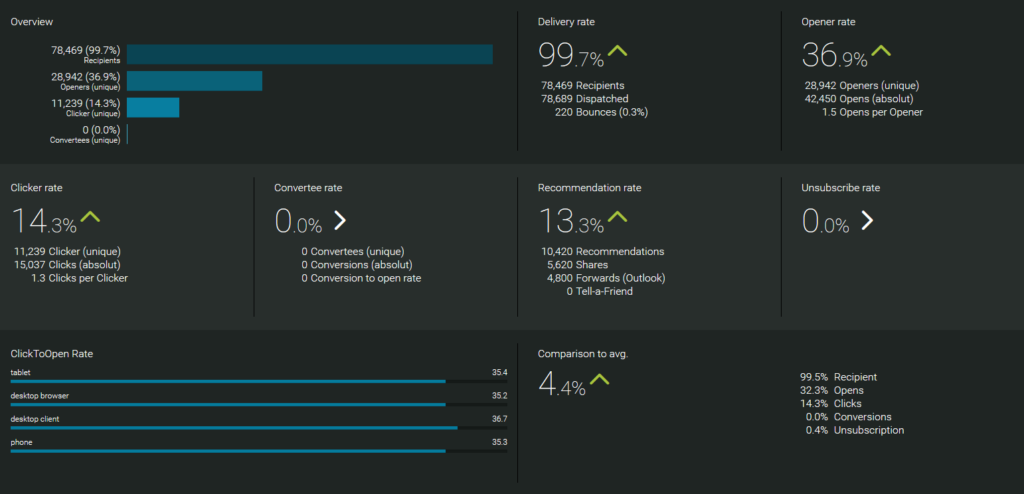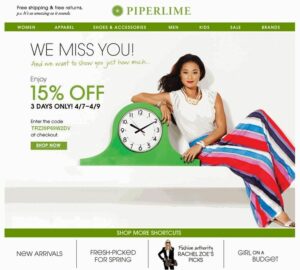“How are your email marketing efforts impacting our business’ success? What was the gain from spending such a large portion of our budget? What do you plan to do to improve your numbers next year?” Mr. Werner is faced with these and similar questions during his performance interview with his supervisor. “I’ll have to look that up again. But I have the impression that we are very successful,” Werner says, because he can’t answer their questions. This awkward interview situation is not the only result of Mr. Werner’s business practices. In the “best” case scenario, Mr. Werner is genuinely successful and “merely” leaves potential for more success untapped. In the worst case scenario, his measures do not work at all or their performance drops. So what can he do?
Many email marketers feel the same way as Mr. Werner. According to Litmus, only 47 percent of email marketers measure their return on investment. After dispatching a campaign, 42 percent of marketers spend less than an hour on evaluation, insight generation and optimization. This is a gross error that not only leads to trouble with superiors, but also leaves Mr. Werner and others blindly stumbling around in the fog. Economic resource allocation, evaluation of measures and optimization become impossible.
Tangible actions: Evaluation
Mr. Werner has promised his supervisor that he will be able to answer her questions at the next performance meeting. And he is motivated to get the most out of his email marketing efforts. But first, he needs to establish meaningful reporting. He makes a plan:
- Reporting of standard KPIs on a regular basis: First of all, after every email sent, Mr. Werner has a report drawn up on standard KPIs such as open rate, click rate and conversion rate. He has reports generated on the KPIs of trigger emails once a month. In addition, there is monthly reporting of subscribers and unsubscribers from the various email distribution lists. With his software, ELAINE from artegic, this was very easy and it gives him an initial overview as well as a sense of how customers are interacting with his measures. As for which relevant KPIs there are, Mr. Werner gleans them from the checklist: The 25 Most Important Email Marketing KPIs, which is available for download at the end of this post.
- KPI benchmarks: Subjectively, Mr. Werner’s KPIs are very good. But Mr. Werner is not entirely sure. Are they better than their competitors, or are they worse? He asks artegic for an industry benchmark and learns that his KPIs are on average for the industry. Gladly, he can do a more comprehensive, free benchmark analysis with artegic to get a more detailed comparison with the competition. He puts a pin in that option and will return to it later.
- Integrating monetary key figures into reporting: The main goal of email marketing in Mr. Werner’s company is to generate sales. He adds the sales generated by email marketing measures to his reporting. He starts with revenues that are directly attributable to his activities, for example revenues generated by conversions after clicks in e-mails. He knows that marketing attribution can be complex. What if the customer has already seen the product they bought on a banner or social media post a few days before they clicked on it in the newsletter? What about email marketing efforts that don’t generate direct sales? These are important questions, but for now, he is satisfied with his approach. To determine the efficiency of email marketing, he adds return-on-investment in the reporting. He applies the monetary metrics in different contexts: monthly, per campaign, for different distribution lists, etc.
- Comparing measures and time periods: How are the measured KPIs evolving? Is performance improving? Is it deteriorating? To find out, Mr. Werner has the development of the figures over time displayed in addition to the figures on individual key dates. He also compares individual measures with each other. Convenient: In ELAINE, he can assign the measures to campaigns, which makes it easier to compare them. The trend is positive. His distribution lists are growing and the responses to his email marketing measures have also improved somewhat over the last few months.

In ELAINE, Mr. Werner can display extensive statistics
Tangible actions: Optimizing
The reporting is ready for the time being. But what can Mr. Werner do with these figures? How does he answer his supervisor’s question, “What do you plan to do to improve your numbers next year?” He has a few ideas:
- Segmentation: Mr. Werner has already segmented his distributors according to simple characteristics. Women get different offers than men for example and he adjusts local temporary offers regarding to the place of residence. In the B2B division of Mr. Werner’s company, campaigns are segmented by industry. Based on the KPIs recorded, Mr. Werner can now see whether the segmentation is working. And he can use the figures to create further segments. For example, are there differences in the KPIs for different age groups? In the article Using Segmentation in Email Marketing, he will find many suggestions for the right segmentation.
- Impact chain analysis: Mr. Werner knows a number of measures for optimizing the individual email marketing KPIs. But which KPI should he optimize? For which measures should he spend his scarce resources? Which measures are the right ones? To be able to answer these questions, he must first understand the chain of effects of his measures, that is, know the relationship between the KPIs. For example, if he could increase the open rate by 1 percent, what impact would that have on the click rate, the conversion rate, the generated revenue? Mr. Werner can find more insights on the topic of impact chain analysis in the article Strategic Derivation of the Right Email Marketing KPIs.
- Testing: The most important measure for the metrics-based optimization of his email marketing measures is testing. Mr. Werner starts with simple A/B tests of his measures, but is already planning more complex multivariate test procedures for the future. Initially, he wants to concentrate on optimizing the subject line, as he has identified a particularly large leverage effect here in the results chain analysis. In a structured manner, he tests different characteristics of the subject line components against each other and compares the opening rates. He gets tips on how best to proceed from the Checkliste: 20 Tips for Successful Testing in Email Marketing, which is available for download at the end of this article.
- Marketing Automation: With ELAINE, Mr. Werner measures the email marketing KPI not only anonymously, but also on a person-by-person basis if a suitable opt-in is available. He can therefore track which customers open, which customers click, which sales they generate, and so on. This allows him to use the person-related KPI as a trigger for automated measures. For example, he can automatically send a reactivation email with a particularly eye-catching subject line and a coupon to customers for whom no opening has been measured for a long time. Further ideas for marketing automation use cases can be found in the Whitepaper: 16 Use Cases for Marketing Automation, which is available for download at the end of this article.

Piperlime reactivates inactive users with voucher emails